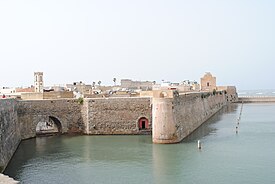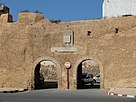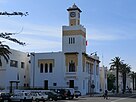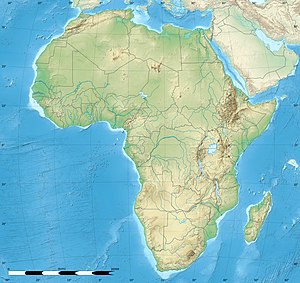El Jadida (Arabic: الجديدة, romanized: al-Jadīda, [alʒadiːda]) is a major port city on the Atlantic coast of Morocco, located 96 kilometres (60 mi) south of the city of Casablanca, in the province of El Jadida and the region of Casablanca-Settat.[5][6] It has a population of 170,956 as of 2023.[7][unreliable source]
El Jadida
الجديدة | |
|---|---|
City | |
Clockwise from top: the old city walls, a colonial-era building in El Jadida, the Portuguese cistern, a market in El Jadida, the gate to the old city | |
| Coordinates: 33°14′N 8°30′W / 33.233°N 8.500°W | |
| Country | Morocco |
| Region | Casablanca-Settat |
| Province | El Jadida |
| Population | |
• Total | 220 181 |
| • Rank | 15th in Morocco |
| Time zone | UTC+1 (CET) |
| Official name | Portuguese City of Mazagan (El Jadida) |
| Type | Cultural |
| Criteria | ii, iv |
| Designated | 2004 (28th session) |
| Reference no. | 1058 |
| Region | Arab States |
The fortified city, built by the Portuguese at the beginning of the 16th century and named Mazagan (Mazagão in Portuguese), was given up by the Portuguese in 1769 and incorporated into Morocco. El Jadida's old city sea walls are one of the Seven Wonders of Portuguese Origin in the World.[8] The Portuguese Fortified City of Mazagan was registered as a UNESCO World Heritage Site in 2004, on the basis of its status as an "outstanding example of the interchange of influences between European and Moroccan cultures" and as an "early example of the realisation of the Renaissance ideals integrated with Portuguese construction technology". According to UNESCO,[9] the most important buildings from the Portuguese period are the cistern and the Church of the Assumption, both in a Manueline style.[10]
The city is a popular resort and destination for both Moroccan and international tourists.[11][12] An important industrial complex, Jorf Lasfar, lies 20 kilometres to the south.[13]
Names
editEl Jadida's other names and nicknames in other languages were: Cap Soleis,[14] Portus Rutilis,[15] Rusibis,[15][16][17] Mazighen (Arabic: مازيغن),[18][19][20][21] al-Breyja (Arabic: البريجة),[15] Mazagão,[14][15] al-Mahdouma (Arabic: المهدومة)[14] and Mazagan.[14][15] The city was renamed al-Jadida in 1820, meaning 'The New'.[22]
History
editEl Jadida traces its origins to the 5th century BC, when it was founded and settled by the Phoenicians.[23]
Prior to the arrival of the Portuguese in the 16th century, an anchorage used by boats appears to have existed at the current site of El Jadida throughout the Middle Ages and in ancient times.[24] The name Mazighan was first documented by the 11th-century Arab geographer al-Bakri.[24] In 1502 a Portuguese captain, Jorge de Mello, landed at this location, allegedly driven here by a storm. He and his crew took refuge in an abandoned tower, called al-Briya or al-Burayja, to defend themselves against any potential attack by the locals.[24][22] After returning to Portugal, he obtained permission from the Portuguese king, Dom Manuel, to found a fortress here in 1505, but evidence indicates that he did not carry this out, as when the Portuguese army passed here on their way to conquer Azemmour in 1513 they found nothing but the old tower.[24]
As Azemmour was difficult to access, the Portuguese returned and built a citadel at the more accessible Mazighan in the summer of 1514.[24] This citadel was a rectangular building with four towers, one of which was the old tower that already stood here.[24][22] The architects were two brothers, Diogo and Francisco de Arruda.[24][9] The location then became known in the Portuguese language as Mazagão. During the next few decades the Sa'dids rose to power and began expelling the Portuguese from their coastal fortresses, with the most significant event being their expulsion from Santa Cruz (present-day Agadir) in 1541. In response, King João III of Portugal ordered the evacuation of Portuguese positions at Azemmour and Safi and concentrated on building a more defensible position at Mazagão instead.[24] As a result, the Portuguese fortification was expanded into the larger walled fortress we see today in 1541.[22][24]
The Kingdom of Portugal would continue to control the city until 1769, when they abandoned Mazagão, their last territory in Morocco. Upon their forced departure, the Portuguese destroyed the Governor's Bastion. Most of the Portuguese inhabitants were sent to the colony of Brazil, where they founded a new settlement called Nova Mazagão (the present Mazagão in the state of Amapá).[25] The city was then taken over by Sultan Mohammed ben Abdallah in 1769 and remained largely uninhabited, having been dubbed al-Mahdouma ('The Ruined').[22] Eventually, Sultan Abd al-Rahman (r. 1822–1859) ordered that a mosque be built, and the destroyed portions of the city were rebuilt during his reign in the early nineteenth-century.[22] In 1820 the city was renamed al-Jadida, meaning 'The New'.[22][12] The town underwent a revival and soon outgrew Azemmour as the most important city in the area. Alongside the Muslim population was also a community of Jews, who participated in the city's revival.[26]
At the beginning of the French Protectorate in Morocco (established in 1912), the city was developed as a tourist resort, one of the earliest initiatives to develop modern tourism in Morocco.[12] By the 1930s it had a casino which was popular with European tourists and colonists.[12] The importance of the city's port, however, declined as Casablanca grew into the major port and urban center of the country during this period.[27][11] In the 1980s a large industrial complex, Jorf Lasfar, was developed some 20 kilometres to the south.[28] Aided by its UNESCO World Heritage Site designation since 2004, the city continues to be a tourist destination today.[12]
During the September 2023 earthquake that struck southern Morocco, the historic Portuguese church in the old city was damaged. As of 13 September, cracks were observed in the church's tower and there was a risk of structural collapse.[29]
Landmarks
editFortress of Mazagan
editThe design of the Fortress of Mazagan is a response to the development of modern artillery in the Renaissance.[30] The star form of the fortress measures c 250m by 300m.[31] The slightly inclined, massive walls are c 8m high on average, with a thickness of 10m, enclosing a patrolling peripheral walkway 2m wide. At the present time the fortification has four bastions: the Angel Bastion in the east, St Sebastian in the north, St Antoine in the west, and the Holy Ghost Bastion in the south. The fifth, the Governor's Bastion at the main entrance, is in ruins, having been destroyed by the Portuguese in 1769. Numerous colonial-era Portuguese cannons are still positioned on top of the bastions.[32]
The fort had three gates: the Seagate, forming a small port with the north-east rampart, the Bull Gate in the north-west rampart, and the main entrance with a double arch in the centre of the south rampart, originally connected to land via a drawbridge. A ditch, c 20m wide and 3m deep, formerly filled with seawater, surrounded the fort. During the time of the French Protectorate the ditch was filled in with earth and a new entrance gate was opened leading to the main street, the Rua da Carreira, and to the Seagate.[citation needed] Along this street are situated the best preserved historic buildings, including the Catholic Church of the Assumption and the Portuguese cistern.
The Citadel
editThe Citadel, located at the heart of the walled city, was the first permanent Portuguese construction on this site in 1514. It is a building with a rectangular floor plan measuring about 47 by 56 metres (154 by 184 ft), with three major rooms around a central space and four towers (one at each corner).[22] The southern El-Briya Tower (originally known as al-Burayja) was of local, pre-Portuguese origin and it was here that the Portuguese first took refuge when they arrived in 1502.[22][24] One of the northern towers was later re-purposed as the base of a 19th-century minaret built for the nearby mosque.[22] The cistern is located beneath the Citadel.
Portuguese cistern
editThe semi-subterranean chamber has a roughly square plan measuring around 33 to 34 metres (108 to 112 ft) per side, was constructed with five rows of five stone pillars and columns.[22] The chamber is built in a late Gothic style known as Manueline, with a vaulted ceiling of brick masonry and stone ribs.[22][10] Its original function is not clear. It may have been an armory, barracks,[33] or granary,[24] but it is recorded as having been converted into a cistern in 1541.[22][24] It was designed by an architect named Miguel de Arruda but the construction work was delegated to João de Castilho.[33] A round opening in the center of the chamber served to collect rainwater.[22] The cistern is famous especially for the thin layer of water that covers the floor and creates fine and ever-changing reflections in the otherwise dark vaulted chamber. Its visual qualities are such that several movies have been filmed within the cavernous space, of which Orson Welles' Othello is the best known internationally.[34]
Churches
editThe Church of Our Lady of the Assumption, a prominent building located south of the Citadel, was the main parish church of the Portuguese settlement. It was constructed or begun when the fortress was expanded in 1541. It has a nave, a choir, a sacristy, and a square-shafted bell tower.[22] At least three other churches existed, though generally only partial remains of them are still present today. Two small churches were adjoined to some of the bastions of the fortress. Another, the Church of Mercy (Misericórdia) was part of the Citadel.[22]
Synagogues
editA number of synagogues also existed inside the old city, attesting to the importance of the Jewish community here in the 19th and 20th centuries.[22] One prominently visible example is the Bensimon Synagogue, inaugurated in 1926 and attached to earlier structures in the northern corner of the former fortress. Its construction was sponsored by four brothers of the Bensimon family: Nessim, Messaoud, Abraham, and Mordechai.[35]
Museum of Resistance and Independence
editLocated near the beach south of the old city and the port, this museum and exhibition space is dedicated to the memory of Moroccan soldiers and resistance to the French Protectorate regime. It is housed in a 20th-century colonial era building constructed in a "Mauresque" style.[36][37]
Climate
editEl Jadida has a hot-summer Mediterranean climate (Köppen climate classification Csa). In winter there is more rainfall than in summer. The average annual temperature in El Jadida is 17.4 °C (63.3 °F). About 372 mm (14.65 in) of precipitation falls annually.[38]
| Climate data for El Jadida | |||||||||||||
|---|---|---|---|---|---|---|---|---|---|---|---|---|---|
| Month | Jan | Feb | Mar | Apr | May | Jun | Jul | Aug | Sep | Oct | Nov | Dec | Year |
| Mean daily maximum °C (°F) | 16.8 (62.2) |
17.5 (63.5) |
19.1 (66.4) |
20.4 (68.7) |
22.3 (72.1) |
24.4 (75.9) |
26.4 (79.5) |
27.9 (82.2) |
25.9 (78.6) |
24.3 (75.7) |
20.7 (69.3) |
18.4 (65.1) |
22.0 (71.6) |
| Mean daily minimum °C (°F) | 7.6 (45.7) |
7.7 (45.9) |
9.3 (48.7) |
10.9 (51.6) |
13.2 (55.8) |
15.9 (60.6) |
17.7 (63.9) |
18.9 (66.0) |
16.9 (62.4) |
14.7 (58.5) |
11.3 (52.3) |
9.0 (48.2) |
12.8 (55.0) |
| Average precipitation mm (inches) | 49 (1.9) |
48 (1.9) |
41 (1.6) |
32 (1.3) |
16 (0.6) |
4 (0.2) |
0 (0) |
1 (0.0) |
7 (0.3) |
34 (1.3) |
66 (2.6) |
74 (2.9) |
372 (14.6) |
| Source: climate-data | |||||||||||||
Economy
editThe city is a significant tourism destination thanks in part to its UNESCO-recognized historic heritage.[12] A large five-star resort, the Mazagan Beach Resort, was opened in 2009 besides the nearby town of Azemmour, named in reference to the historic Portuguese fort. The resort was part of a wider strategy launched in 2001 by King Mohammed VI to boost tourism in Morocco by creating, with the help of foreign investors,[12] large coastal resorts in El Jadida, Essaouira, Saïdia, and other cities on the Moroccan coast.[12][39] The city is also a popular summer holiday resort for Moroccan families.[11]
Since the 1980s the city's economy has benefited[28] from the large industrial complex at Jorf Lasfar, located some 20 kilometres to the south.[13] The complex, managed by the Office Chérifien du Phosphore, is the main processing center for the region's phosphate reserves and its port is used for exporting its related products.[13][40][41] It also serves as a base for other industries.[13]
Education
editThe city houses many post-secondary academic institutions:
Chouaib Doukkali University,[42][43] including the following institutions:
- Faculty of Science[44]
- Faculty of Letters and Humanities[45]
- Faculty of Juridical, Economic and Social Sciences[46]
- National School of Applied Sciences (ENSA)[47]
- National School of Business and Management (ENCG)[48]
- Superior School of Technology (EST) - Sidi Bennour[49] (Outside El Jadida)
Office of Vocational Training and Promotion of Labor (OFPPT),[50] including the following institutions:
- Professional Qualification Center (CQP)[51]
- Specialized Institute of Applied Technology (ISTA) - Al-Massira[52]
- Specialized Institute of Applied Technology (ISTA) - City-of-the-Air[53]
- Specialized Institute of Hotel and Tourism Technology (ITHT) - El jadida[54]
- Specialized Institute of Hotel and Tourism Technology (ITHT) - Al Haouzia[54]
Others:
- Regional Centers for the Professions of Education and Training (CRMEF)[55]
- Section of "Higher Technician Certificate" (BTS) (at ar-Razi Technical High-School)[56]
- Section of "Preparatory Classes for Great Schools" (CPGE) (at ar-Razi Technical High-School)[57]
- Higher Institute of Engineering and Business (ISGA)[58] (private)
Sports
editThe main football club of the city is Difaâ Hassani El Jadidi, currently playing in the Botola Pro 1.
Nearby cities
editNear El Jadida, are located the city of Azemmour in the northeast and the town of Sidi Bouzid in the southwest. Within a perimeter of around 120 km or less, are located Casablanca, Berrechid, Settat, Sidi Bennour, Oualidia, Youssoufia, Safi.
Notable people
editThis section needs expansion. You can help by adding to it. (August 2019) |
- Jaafar Aksikas, author
- Driss Chraïbi, author
- André Elbaz, painter and filmmaker
- André Guelfi, racing driver
- Zakaria Hadraf, footballer
- Driss Jettou, former prime minister, president of the Supreme Audit Court
- Youssef Kaddioui, former international footballer
- El Mehdi Karnass, footballer
- Abdelkebir Khatibi, author
- Abdellah Lahoua, footballer
- Yousra Mansour, vocalist of Bab L' Bluz
- Mohamed Nahiri, footballer
- Chaïbia Talal, painter
- Suleiman Zanfari, racing driver
- Nicola L, multidisciplinary artist
- Naji El-Mekki, pentathlete
Twin towns – sister cities
editEl Jadida is twinned with:
See also
editReferences
edit- ^ "Résultat du RGPH 2014 Casablanca-Settat par région, préfecture, municipalité et commune" (in Arabic and French). Royaume du Maroc - Haut-Comissariat au Plan. Retrieved 9 September 2019.
- ^ "Indicateurs RGPH2014 - Démographie - Commune : El Jadida" (in French). Royaume du Maroc - Haut-Comissariat au Plan. Retrieved 9 September 2019.
- ^ "عدد السكان القانونيين بالمملكة". Official Gazette المملكة المغربية - الجريدة الرسمية - النشرة العامة. 6354 (year 104): 4025–4075. 23 April 2015. ISSN 0851-1195. Archived from the original (PDF) on 7 November 2019. Retrieved 9 September 2019.
- ^ "POPULATION LÉGALE DES RÉGIONS, PROVINCES, PRÉFECTURES, MUNICIPALITÉS, ARRONDISSEMENTS ET COMMUNES DU ROYAUME D'APRÈS LES RÉSULTATS DU RGPH 2014" (in Arabic and French). High Commission for Planning, Morocco. 8 April 2015. Retrieved 29 September 2017.
- ^ "الجهات و تسمياتها و مراكزها و العمالات و الأقاليم المكونة لها" (PDF). Official Gazette المملكة المغربية - الجريدة الرسمية - النشرة العامة. 6340 (year 104): 1461–1533. 15 March 2015. ISSN 0851-1195. Archived from the original (PDF) on 31 July 2020. Retrieved 9 September 2019.
- ^ "المغرب يتبنى تقسيما ترابيا جديدا" (in Arabic and French). المديرية العامة للجماعات المحلية. Archived from the original on 30 July 2020. Retrieved 9 September 2019.
- ^ "Population of El Jadida" (in Arabic and French). population-hub. Retrieved 9 September 2019.
- ^ Paula Hardy; Heidi Edsall; Mara Vorhees (2005). Morocco. Lonely Planet. ISBN 1-74059-678-1.
El Jadida.
- ^ a b "Portuguese City of Mazagan (El Jadida)". UNESCO World Heritage Centre. Retrieved 2013-02-10.
- ^ a b "Portuguese City of Mazagan (El Jadida)". Unesco. Retrieved May 25, 2020.
- ^ a b c Gilbert, Sarah; Balsam, Joel; Lioy, Stephen; O'Neill, Zora; Parkes, Lorna; Ranger, Helen; d'Arc Taylor, Stephanie (2021). "El Jadida". Lonely Planet Morocco (13th ed.). Lonely Planet. ISBN 978-1-83869-255-1.
- ^ a b c d e f g h Sarmento, João (2011). Fortifications, Post-colonialism and Power: Ruins and Imperial Legacies. Routledge. pp. 128–133. ISBN 978-1-317-13387-2.
- ^ a b c d The Report: Morocco 2014. Oxford Business Group. 2014. p. 159. ISBN 978-1-910068-05-2.
- ^ a b c d "Aperçu historique d'El Jadida" (in French). eljadidama.unblog.fr. 27 November 2008. Retrieved 10 September 2019.
- ^ a b c d e Mustapha Jmahri. "El Jadida" (in French). Dar Del Mare. Archived from the original on 4 January 2022. Retrieved 10 September 2019.
- ^ "Mazagan hier, El Jadida aujourd'hui" (in French). Golf El Jadida. Retrieved 10 September 2019.
- ^ Bill Thayer (31 January 2010). "Location of Mauritania Tingitana (from the First Map of Libya)". Bill Thayer. Retrieved 10 September 2019.
- ^ (1154) Hamoudi Husseini Cherif Al-Idrisi, Muhammad ibn Muhammad ibn Abd-Allah ibn Idriss; Tabula Rogeriana. Tabula Rogeriana نزهة المشتاق في اختراق الآفاق. مكتبة الثقافة الدينية. p. 550.
{{cite book}}: CS1 maint: numeric names: authors list (link) - ^ Qadi Ayyadh, Ibn Mussa ibn Ayyadh Sabti; Qadi Abu Abd-Allah, Muhammad Muhammad Ibn Sharifa (1997). مذاهب الحكام في نوازل الأحكام (PDF) (2nd ed.). دار الغرب الإسلامي. p. 346.
- ^ (Before 1274) Ibn Sa'id al-Maghribi, Abu al-Ḥassan Ali ibn Mussa; (1958) Ginés, Juan Vernet (1958). بسط الأرض في الطول والعرض. Moulay Hassan Institute - Tetuan. p. 141.
{{cite book}}: CS1 maint: numeric names: authors list (link) - ^ مبارك بلقاسم (26 June 2018). "مازيغن هو الاسم الأصلي لمدينة الجديدة المغربية Maziɣen" (in Arabic). Hespress. Retrieved 10 September 2019.
- ^ a b c d e f g h i j k l m n o p q Proposition d'inscription de biens sur la Liste du patrimoine mondial: Cité portugaise Mazagan (El Jadida) (Nomination text for UNESCO World Heritage List) (in French). 2004.
- ^ Porter, Darwin (1987). Frommer's Spain and Morocco on Forty Dollars a Day. John Wiley & Sons, Incorporated. p. 517. ISBN 978-0-671-62061-5.
- ^ a b c d e f g h i j k l Colin, G.S.; Cenival, P. de (1960–2007). "al-D̲j̲adīda". In Bearman, P.; Bianquis, Th.; Bosworth, C.E.; van Donzel, E.; Heinrichs, W.P. (eds.). Encyclopaedia of Islam, Second Edition. Brill. ISBN 9789004161214.
- ^ Jean Duvignaud, Laurent Vidal (2005). Mazagão, la ville qui traversa l'Atlantique : du Maroc à l'Amazonie, 1769-1783. Paris: Aubier. p. 314. ISBN 2-70072360-0.
- ^ Tavim, Jose Alberto (2010). "El Jadida (Mazagan)". In Stillman, Norman A. (ed.). Encyclopedia of Jews in the Islamic World. Brill. ISBN 9789004176782.
- ^ Suárez Bosa, Miguel (2020). "Modernization and Development of the Moroccan Port Model during the French Protectorate (1912–1956)". In Olukoju, Ayodeji; Hidalgo, Daniel Castillo (eds.). African Seaports and Maritime Economics in Historical Perspective. Palgrave Macmillan. p. 99. ISBN 978-3-030-41399-6.
- ^ a b Godin, Lucien; Le Bihan, Gérard (2012). "Moroccan Medinas: Meknes and Azemmour". In Balbo, Marcello (ed.). The Medina: The Restoration and Conservation of Historic Islamic Cities. Bloomsbury Publishing. ISBN 978-1-78672-497-7.
- ^ Hamri, Salma (13 September 2023). "27 sites historiques ont été gravement endommagés par le séisme du 8 septembre selon un premier constat". Médias24 (in French). Retrieved 15 September 2023.
- ^ "Portuguese City of Mazagan (El Jadida) - UNESCO Advisory Body Evaluation" (PDF). Retrieved 2013-02-10.
- ^ "DGPC | Cidade Portuguesa de Mazagão (El Jadida)". www.patrimoniocultural.gov.pt. Retrieved 2020-12-07.
- ^ "Fortress of Mazagan". Starforts. Retrieved May 25, 2020.
- ^ a b La citerne (Information sign). Posted inside museum, at entrance of cistern. 9 June 2015.
- ^ "Portuguese Cistern of El Jadida". Atlas Obscura. Retrieved May 25, 2020.
- ^ Choukaili, Khadija (26 February 2019). "El Jadida: Projet de réhabilitation de la synagogue Bensimon". El Jadida Scoop (in French). Retrieved 9 October 2022.
- ^ "Museum of Resistance And Independence". Morocco Tourism Info. Retrieved 2022-10-09.
- ^ "El Jadida a son musée de la Résistance et de l'armée de libération – Mazagan24 – Portail d'El Jadida" (in French). Retrieved 2022-10-09.
- ^ "Climate El Jadida ⵍⵊⴰⴷⵉⴷⴰ الجديدة". climate-data.org. Retrieved 9 September 2019.
- ^ The Report: Morocco 2012. Oxford Business Group. 2012. p. 173. ISBN 978-1-907065-54-5.
- ^ Information Circular. U.S. Department of the Interior, Bureau of Mines. 1984. p. 15.
- ^ Weiss, Walter M. (2016). Morocco: In the Labyrinth of Dreams and Bazaars. Haus Publishing. ISBN 978-1-909961-32-6.
- ^ "Chouaïb Doukkali University" (in French). 9rayti.co. Retrieved 9 September 2019.
- ^ "Chouaib Doukkali University" (in Arabic, French, and English). Chouaib Doukkali University. Retrieved 9 September 2019.
- ^ "Faculty of Science" (in French). Archived from the original on 9 September 2019. Retrieved 9 September 2019.
- ^ "Faculty of Letters and Humanities" (in Arabic). Faculty of Letters and Humanities. Retrieved 9 September 2019.
- ^ "Faculty of Juridical, Economic and Social Sciences" (in French). Faculty of Juridical, Economic and Social Sciences. Retrieved 9 September 2019.
- ^ "National School of Applied Sciences" (in French). National School of Applied Sciences. Retrieved 9 September 2019.
- ^ "National School of Business and Management" (in French). National School of Business and Management. Archived from the original on 7 September 2019. Retrieved 9 September 2019.
- ^ "Superior School of Technology - Sidi Bennour" (in French). Superior School of Technology - Sidi Bennour. Retrieved 9 September 2019.
- ^ "Office of Vocational Training and Promotion of Labor" (in Arabic, French, and English). Office of Vocational Training and Promotion of Labor. Retrieved 9 September 2019.
- ^ "Professional Qualification Center" (in Arabic, French, and English). Office of Vocational Training and Promotion of Labor. Archived from the original on 20 August 2022. Retrieved 9 September 2019.
- ^ "Specialized Institute of Applied Technology - Al Massira" (in Arabic, French, and English). Office of Vocational Training and Promotion of Labor. Retrieved 9 September 2019.
- ^ "Specialized Institute of Applied Technology - City of the Air" (in Arabic, French, and English). Office of Vocational Training and Promotion of Labor. Archived from the original on 20 August 2022. Retrieved 9 September 2019.
- ^ a b "Specialized Institute of Hotel and Tourism Technology - El Haouzia" (in French). Office of Vocational Training and Promotion of Labor. Archived from the original on 18 April 2021. Retrieved 9 September 2019.
- ^ "Regional Centers for the Professions of Education and Training" (in French). Regional Centers for the Professions of Education and Training. Retrieved 9 September 2019.
- ^ "Everything about El Jadida BTS" (in French). inscription.ma. Retrieved 9 September 2019.
- ^ "2019/2020 CPGE public institutions" (in French). National Center of Pedagogical Innovation and Experimentation. Retrieved 9 September 2019.
- ^ "Higher Institute of Engineering and Business" (in French). Higher Institute of Engineering and Business. Retrieved 9 September 2019.
- ^ "Gemellaggi". comune.arenzano.ge.it (in Italian). Arenzano. Retrieved 2020-11-02.[permanent dead link]
- ^ "Geminações e Acordos de Cooperação". cm-barcelos.pt (in Portuguese). Barcelos. Retrieved 2020-11-02.
- ^ "Coopération Internationale". nabeul.gov.tn (in French). Gouvernorat de Nabeul. Retrieved 2020-11-02.
- ^ "Le jumelage". sete.fr (in French). Sète. Retrieved 2020-11-02.
- ^ "Geminações e Cooperações". cm-sintra.pt (in Portuguese). Sintra. Retrieved 2020-11-02.
- ^ "Parcs et sites d'activités". ville.varennes.qc.ca (in French). Ville de Varennes. Retrieved 2020-11-02.
- ^ "Jumelages". ville-vierzon.fr (in French). Vierzon. Retrieved 2020-11-02.
- ^ "Tacoma's Sister Cities". cityoftacoma.org. City of Tacoma. Retrieved 2020-11-02.
External links
edit- ((in Arabic, English, French, and Spanish)) Official Morocco website






